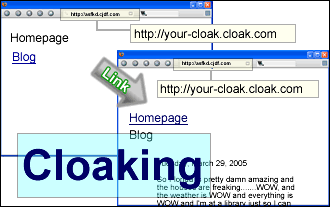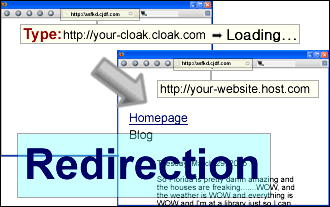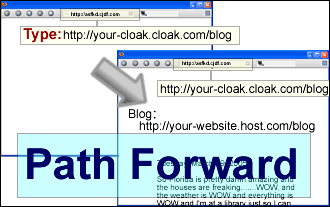Subdomain & Domain Maskers
Skip to:
What is a subdomain/domain?
What is a cloak/mask?
How to break out of the cloak
Pros and Cons of using a cloak
Other things a cloak can do
Information about Free Domains
Links to Cloaks
What is a subdomain/domain?
Well first of all I’m sure you all know what a subdomain is but just to review. A subdomain is a URL that is something like your-website.someother-domain.com; while a domain is www.someother-website.com. Now, some free webhosts will host you on a subdomain, but sometimes your website will be hosted in some kind of subdirectory (such as www.some-webhost.com/dir/y/your-website/), that even you can’t remember. Now then you could probably use a shorter-URL, which is something that a cloak/mask can provide for you.
Now then let’s move on to what a mask is.
A subdomain masker essentially allows you to use a subdomain from a different website that hosts you. A domain masker is pretty much the same thing, except instead of a sudomain it’s top level domain. However, neither will work exactly the same way as a real domain or subdomain. Since there are hundreds of free subdomain/domain maskers out there, you shouldn’t have any trouble finding an extension that fits you. Be it something like bob.fish.com or adventu.ro.us
Essentially a cloak/mask allows someone to type you.mask.com into the URL bar in your web browser to get to your site, which would be at some-other-website.com/your-website/ . So no matter which page a visitor is on, the URL bar will always show it as you.shortened-url.com . There are some problems with this since if someone tries to bookmark a page they’ll always end up on your homepage. Also if a visitor, who is visiting through a cloak, follows a link to another website from your website, the cloak will stay with them. So say you’ve linked to MSN, and the visitor clicks the link. The URL Location bar will continue to show it as you.mask.com.
Example:

How to link to other sites to get out of a cloak
To correctly link to another website and free your visitor from the cloak or frames, simply add target=”_top” to all your link commands in HTML.
Example:
<a href=”the URL” target=”_top”>some text</a>
Pros vs Cons
Now here are some (not all of the) pros and cons to using a cloak.
| Pros | Cons |
|
|
What else can it do?
You should be aware that you can just have the cloak redirect to your website. So the sub-domain/domain that you signed up for pretty much acts like an automatic link that redirects to your website.
Example:

There are a few extras to look out for though.
DNS & dynamic IP: They allow you to use a domain/subdomain almost exactly the same way you would use it if it were a real full fledged domain. However, to be able to use those features, your webhost needs to support them.
URL path forwarding: Petty much path forwarding allows you to type in you.shortened-url.com/photos.html, and then the cloak will bring up you.some-other-website-that-hosts-your-website.com/photos.html, and the location bar will say that it’s located at you.shortened-url.com/photos.html .
Example:

Information about free “domains.”
Most free “domain” names are simply subdomains of domains which are only a few letters long. Sometimes they’re called subdomains (as they should be), other times some people try to pass them off as real domains (usually it’s harmless ,sometimes they’re trying to sell overpriced subdomains.)
Also a lot of time they use foreign domain extensions to make the subdomains look more unique and snazzy; like v3.com uses several foreign extensions like .to (Kingdom of Tonga) or .at (Austria). So that they can offer you unique subdomains such as you.all.at or you.hello.to.
.co.nr (NR = Nauru) is a good example of a domain name extension that looks real, but really isn’t, since it was registered by a Russian citizen. For all intents and purposes it might as well be real, though.
On the other hand .tk (Tokelau) is real registrar, that offers free domains (with fewer features).